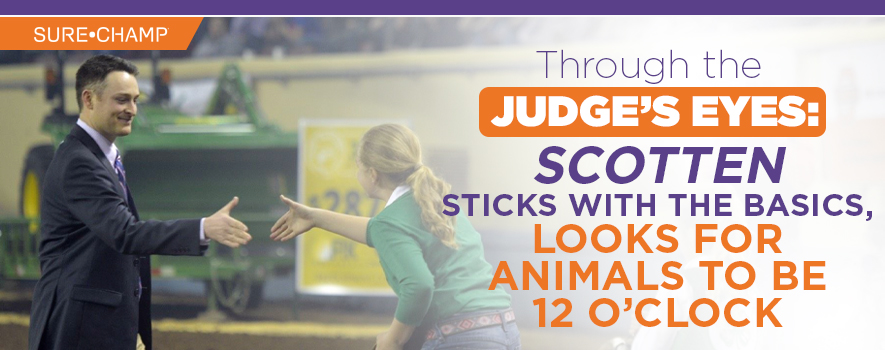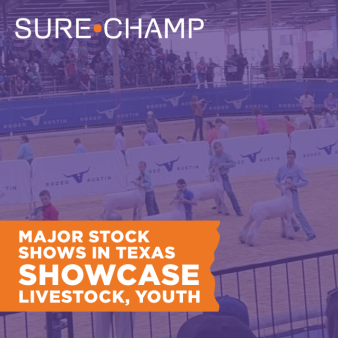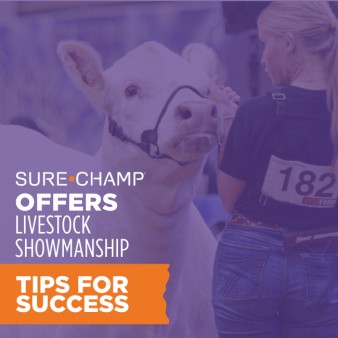
Spencer Scotten knows what it takes to make a champion. And his criteria for a champion market goat or breeding doe probably aren’t too much different than any other judges since he’s looking for a balance of width, muscle, boldness, balance and structure. However, when an exhibitor hits the ring, his or her goat best be dialed in and looking its best.
“I am a big first impression guy. They are going to strike me either good or bad in the first five seconds they come in. Show ring presence is important. If they are fresh haired, and have been taken care of, if they have been kept clean and they come in bright white with fresh hide and hair that helps so much with that first impression,” Scotten said. “It’s not just about having a good one. You have to make sure they are 12 o’clock and well presented to make sure to win those big shows.”
Boer goats, in general, made a good first impression on Scotten as he grew up on his family’s club calf operation at Nevada, Missouri, where his dad and uncle raise and sell show calves. He had always shown lambs and pigs, but his brother’s ag teacher gave him a goat when he got to high school and the brothers took the goat to a few shows and won. They were hooked; they purchased their own does and started a goat operation which they owned and operated until they both went separate ways with their careers.
Scotten’s career path took him to El Reno, Oklahoma, three years ago, where he took the job as the livestock judging coach at Redlands Community College. In addition to coaching, he enjoys judging shows across the country, and still helps on his family’s club calf operation as time allows.
Practical Priorities
With experience in all species, Scotten said goats are no different than any other animal, and he likes to prioritize the basics, especially when evaluating market animals.
“Really like any market animal, my emphasis is muscle and skeletal width, and they have got to be good carcass animals first. Wide, bold and muscular. That is my first sort. Then like any other species, I go to structure. They have to be sound and balanced,” he said. “Whenever you get all that, then you can add the bells and whistles that make them cool to look like a really neat neck and extra foot and bone.”
When Scotten judges breeding does, he switches up his priorities slightly to put more emphasis on structure and balance instead of muscle. That doesn’t mean that muscle goes away entirely.
“I’m still looking for one that is skeletally correct and can do her job. So, the right kind of structure, right kind of body type and I like them a little stouter than most. Even in a female, I like them to be wide chested, bold ribbed and to have some dimension to them, while still being smooth and looking like a female, that is where I like to be,” he said.
Getting to 12 o’clock
Although Scotten appreciates a wether or doe that is dialed in and looking its best, he also understands that this doesn’t happen overnight or without some guidance. He recommends that families that are just getting started be patient with the process and ask a lot of questions.
“The biggest piece of advice I would have is to let other people help you. Be open to suggestions. There is a reason they are successful. That’s how we would learn. Buy livestock from people who are winning, let them help you; You are not going to figure it all out by yourself,” he said.
He also suggests that the Boer goat industry has become very competitive and that it might take a year or two to get your feet wet, figure out the type and kind of animals you want to show and the feeding program. However, once you have found a reputable buyer and mentor, make sure you ask questions, practice showmanship daily and work hard to have your animals highly presented when you walk into the ring. When you #PreptoWin that makes all the difference.
“You have got to have them fresh, and you have got to have them right with their hide and hair and everything right when you come in, especially at a major show. You can get by at a smaller show if you don’t have everything on point. But whenever you go to a state fair or major show or competitive jackpot, you have to do all your homework when you go to those. I’ve seen lots of really good ones get beat solely on showmanship because the judge never can get a good look at them set up,” Scotten said.
Support Starts at Home
Scotten said his family, especially his dad Shannon, have always supported him in his endeavors. He appreciates the encouragement and inspiration while growing up in the livestock industry and pursuing his dreams.
“He is 100% supportive. He would push me to do the very best at whatever I was doing. Always support and push me to do as well as I could. Constantly,” he said.
That is about as much as any exhibitor can ask for – in or out of the ring. A supportive family that pushes them to give their all. In Scotten’s eyes if you have a wide, heavily muscled, bold, market goat that is great structured with balance and eye appeal the is dialed-in with the right degree of show ring presence you are going to catch his eye.

